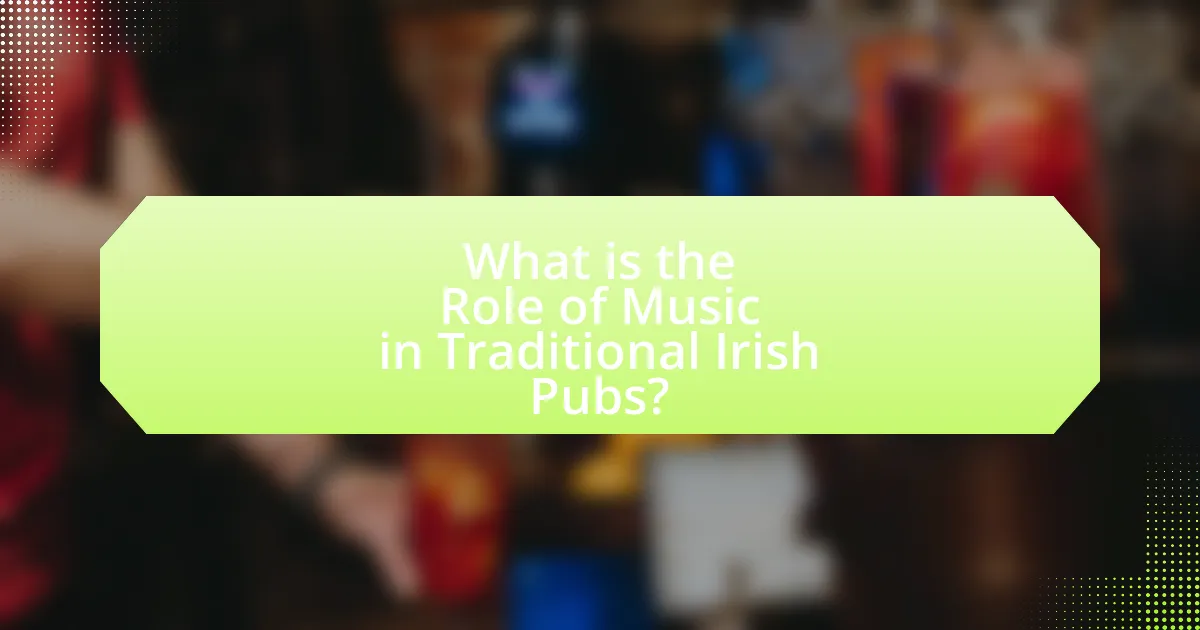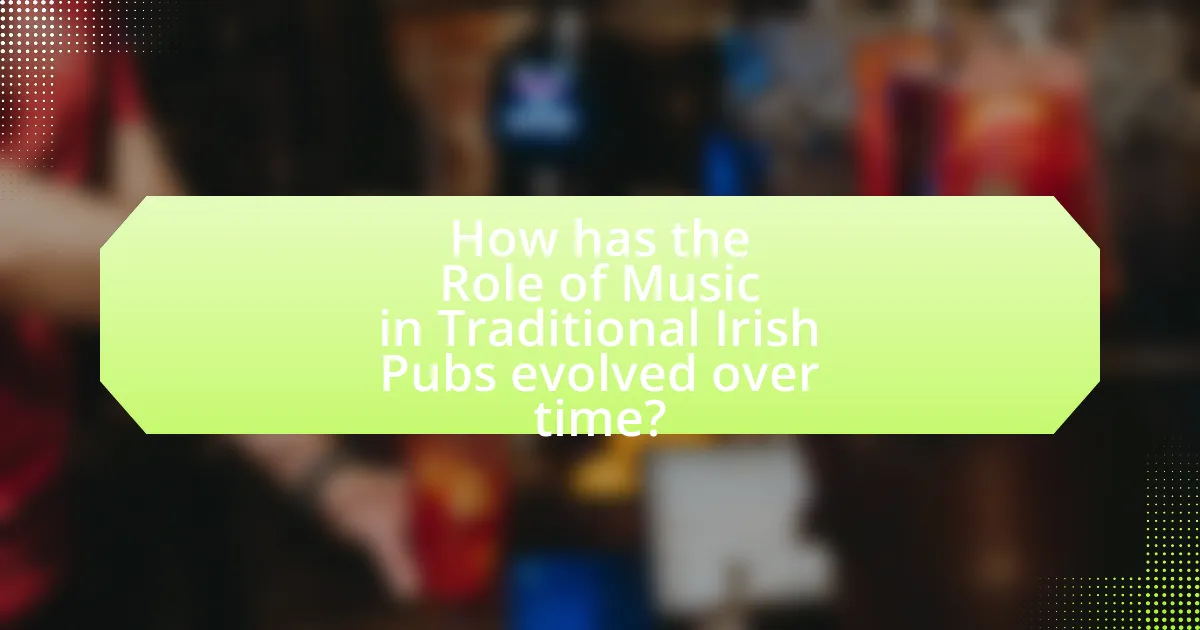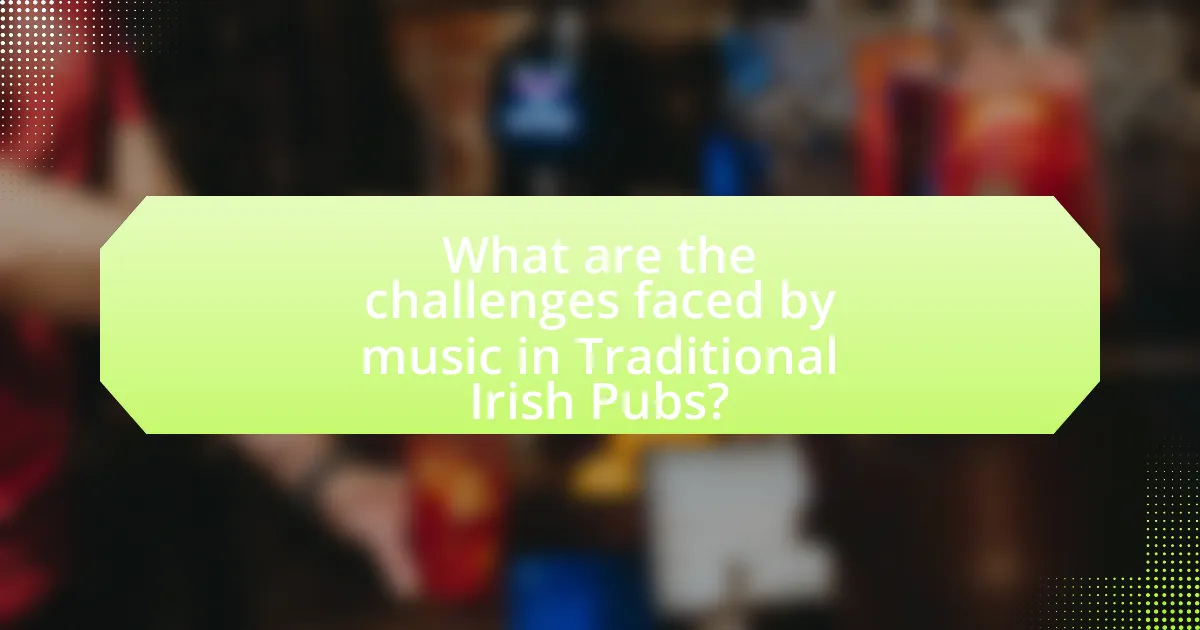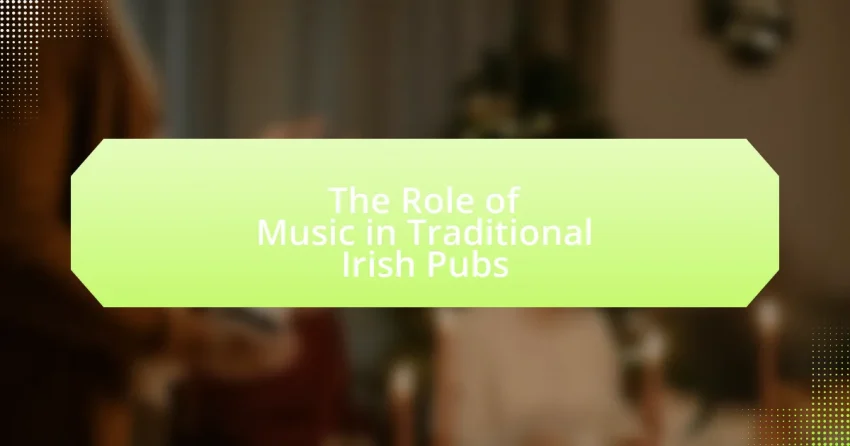The article examines the pivotal role of music in traditional Irish pubs, highlighting its significance in fostering community, cultural identity, and social interaction. It discusses how live performances, featuring traditional instruments like the fiddle and bodhrán, enhance the pub atmosphere and contribute to customer satisfaction and economic support for local communities. The piece also explores the evolution of musical styles within these settings, the challenges faced by musicians, and strategies for preserving traditional music while adapting to modern trends. Additionally, it outlines best practices for patrons to enhance their experience while enjoying live music in these cultural hubs.

What is the Role of Music in Traditional Irish Pubs?
Music plays a central role in traditional Irish pubs by fostering a sense of community and cultural identity. It serves as a medium for social interaction, where patrons gather to enjoy live performances, often featuring traditional instruments like the fiddle and bodhrán. This musical engagement not only enhances the atmosphere but also preserves Irish cultural heritage, as many songs recount historical events and local stories. Research indicates that live music in pubs can increase customer satisfaction and encourage longer visits, thereby supporting the local economy.
How does music contribute to the atmosphere in traditional Irish pubs?
Music significantly enhances the atmosphere in traditional Irish pubs by fostering a sense of community and cultural identity. The lively tunes and traditional melodies encourage patrons to engage with one another, creating an inviting and warm environment. Research indicates that live music performances, often featuring instruments like fiddles and bodhráns, can increase social interaction and enjoyment among customers, leading to longer visits and higher spending. Additionally, the historical context of Irish music, rooted in storytelling and communal experiences, reinforces the pub as a social hub, making it a vital part of Irish culture and heritage.
What types of music are commonly played in these settings?
Traditional Irish pubs commonly feature folk music, including traditional Irish ballads and instrumental tunes. This genre often includes instruments such as the fiddle, bodhrán, and tin whistle, which are integral to the cultural heritage of Ireland. The prevalence of folk music in these settings is supported by its historical significance in Irish social gatherings, where music serves to enhance community bonding and cultural expression. Additionally, contemporary interpretations of traditional music, such as Celtic rock, are also popular, reflecting the evolving nature of musical traditions in these environments.
How does live music differ from recorded music in pubs?
Live music in pubs differs from recorded music primarily in its interactive and spontaneous nature. Live performances create a unique atmosphere, allowing for audience engagement and participation, which enhances the communal experience typical of traditional Irish pubs. In contrast, recorded music offers a consistent sound but lacks the dynamic interaction between performers and patrons. Studies show that live music can increase customer satisfaction and retention, as it fosters a sense of community and connection among attendees, which recorded music does not replicate.
Why is music considered an essential part of the pub experience?
Music is considered an essential part of the pub experience because it enhances social interaction and creates an inviting atmosphere. In traditional Irish pubs, live music fosters a sense of community, encouraging patrons to engage with one another and participate in the cultural heritage of the setting. Studies have shown that environments with music can increase customer satisfaction and prolong visits, as music stimulates positive emotions and memories associated with social gatherings. This connection between music and social bonding is particularly evident in Irish culture, where traditional music sessions often serve as a focal point for communal enjoyment and storytelling.
What cultural significance does music hold in Irish pub traditions?
Music holds immense cultural significance in Irish pub traditions as it serves as a vital medium for community bonding, storytelling, and the preservation of Irish heritage. In traditional Irish pubs, live music sessions often feature instruments like the fiddle, bodhrán, and tin whistle, creating an atmosphere that encourages social interaction and participation. This practice not only fosters a sense of belonging among patrons but also reinforces cultural identity by passing down folk songs and narratives that reflect Ireland’s history and values. The prevalence of music in these settings is supported by the fact that many pubs host regular sessions, attracting both locals and tourists, thereby sustaining the tradition and ensuring its continuity across generations.
How does music foster social interaction among patrons?
Music fosters social interaction among patrons by creating a shared experience that encourages communication and connection. In traditional Irish pubs, live music often serves as a catalyst for conversation, as patrons bond over familiar songs and rhythms. Research indicates that music can enhance social cohesion by providing a common ground for individuals to engage with one another, facilitating interactions that might not occur otherwise. For example, a study published in the Journal of Music Therapy found that group music-making activities significantly increased social engagement among participants, highlighting music’s role in breaking down social barriers and fostering relationships.
What role do musicians play in traditional Irish pubs?
Musicians in traditional Irish pubs serve as cultural ambassadors, providing live music that enhances the social atmosphere and fosters community engagement. Their performances often include traditional Irish folk songs and instrumental pieces, which not only entertain patrons but also preserve and promote Irish musical heritage. This role is crucial, as live music in pubs has been a longstanding tradition, dating back centuries, where it acts as a catalyst for social interaction and cultural exchange among locals and visitors alike.
How do musicians engage with the audience during performances?
Musicians engage with the audience during performances by creating an interactive atmosphere that encourages participation and connection. They often use techniques such as eye contact, inviting audience members to sing along, and responding to audience reactions, which fosters a sense of community. For example, in traditional Irish pubs, musicians frequently play familiar tunes that prompt patrons to join in, enhancing the overall experience. This engagement is supported by the cultural significance of music in these settings, where social interaction is a key component of the performance, making the audience feel like an integral part of the event.
What skills are essential for musicians performing in pubs?
Essential skills for musicians performing in pubs include strong musical proficiency, adaptability, and audience engagement. Musicians must possess a solid understanding of various musical genres to cater to diverse audiences, as pubs often feature a mix of traditional and contemporary music. Adaptability is crucial, as musicians may need to adjust their setlists based on crowd reactions or requests. Additionally, effective audience engagement skills, such as storytelling and interaction, enhance the overall experience, fostering a lively atmosphere that encourages patron participation. These skills collectively contribute to a successful performance in the dynamic pub environment.

How has the Role of Music in Traditional Irish Pubs evolved over time?
The role of music in traditional Irish pubs has evolved from informal, community-based gatherings to a more commercialized and performance-oriented experience. Historically, music in these pubs served as a means of social interaction and cultural expression, with local musicians playing traditional instruments like the fiddle and bodhrán during communal sessions. Over time, particularly from the late 20th century onward, the rise of tourism and globalization led to a shift where live music became a key attraction for visitors, often featuring professional bands and a wider variety of genres. This transition reflects a blend of preserving traditional Irish music while adapting to contemporary entertainment demands, as evidenced by the increasing presence of scheduled performances and music festivals in pub settings.
What historical influences have shaped the music played in Irish pubs?
The music played in Irish pubs has been shaped by various historical influences, including the Gaelic cultural revival, British colonialism, and the diaspora of Irish immigrants. The Gaelic cultural revival in the late 19th and early 20th centuries emphasized traditional Irish music, leading to its prominence in social settings like pubs. British colonialism introduced a mix of musical styles, including English folk and military music, which blended with local traditions. Additionally, the Irish diaspora, particularly in the United States, influenced the evolution of pub music by incorporating elements from other cultures, resulting in a diverse musical landscape that reflects both heritage and adaptation.
How did traditional Irish music develop within pub culture?
Traditional Irish music developed within pub culture as a communal expression of identity and social interaction. Pubs served as gathering places where musicians and patrons engaged in informal sessions, fostering a vibrant atmosphere for the performance and sharing of music. This practice became particularly prominent in the 20th century, as pubs began to host regular music nights, allowing local musicians to showcase their talents and encouraging participation from the audience. The integration of traditional instruments like the fiddle, bodhrán, and tin whistle in these settings reinforced the cultural significance of the music, making it an integral part of the Irish social fabric. The rise of the “session” format, where musicians play together in an informal setting, exemplifies how pub culture nurtured the evolution and preservation of traditional Irish music.
What changes have occurred in musical styles over the decades?
Musical styles in traditional Irish pubs have evolved significantly over the decades, transitioning from purely traditional folk music to a blend of contemporary genres. In the mid-20th century, traditional Irish music, characterized by instruments like the fiddle, tin whistle, and bodhrán, dominated pub performances. By the 1980s and 1990s, influences from rock, pop, and even jazz began to permeate the scene, leading to the emergence of fusion genres such as Celtic rock. This shift was evidenced by bands like The Pogues and The Chieftains, who incorporated modern elements while retaining traditional roots. Today, Irish pubs often feature a diverse range of musical styles, including contemporary pop and world music, reflecting broader global trends and the changing tastes of patrons.
How do modern trends impact the role of music in these pubs?
Modern trends significantly enhance the role of music in traditional Irish pubs by integrating technology and diverse musical styles to attract a broader audience. The rise of digital streaming platforms allows pubs to curate playlists that reflect contemporary tastes, while live performances increasingly feature a mix of traditional Irish music and popular genres, appealing to both locals and tourists. Additionally, social media promotes events and performances, increasing visibility and engagement, which has been shown to boost patron attendance by up to 30% during live music nights. These trends collectively transform the musical landscape of pubs, making them vibrant social hubs that cater to evolving consumer preferences.
What genres are gaining popularity in contemporary Irish pubs?
Contemporary Irish pubs are increasingly embracing genres such as folk, rock, and traditional Irish music. The resurgence of folk music, characterized by its storytelling and acoustic elements, resonates with patrons seeking authentic cultural experiences. Additionally, rock music, particularly classic and indie rock, has gained traction, appealing to a younger audience and creating a lively atmosphere. Traditional Irish music remains a staple, often blended with modern influences, reflecting the evolving musical landscape in these venues. This trend is supported by the growing popularity of live music events and festivals in Ireland, which showcase a diverse range of genres and attract a wide audience.
How do technology and social media influence live performances?
Technology and social media significantly enhance live performances by increasing audience engagement and expanding reach. For instance, platforms like Instagram and Facebook allow artists to share live streams and behind-the-scenes content, attracting larger audiences and fostering a sense of community. According to a study by the International Journal of Arts Management, 70% of performers reported that social media increased their audience size and interaction during live events. Additionally, technology such as sound and lighting equipment improves the overall quality of performances, making them more appealing to attendees. This combination of enhanced visibility and improved performance quality demonstrates the profound impact of technology and social media on live music events, particularly in settings like traditional Irish pubs.

What are the challenges faced by music in Traditional Irish Pubs?
Music in Traditional Irish Pubs faces several challenges, including noise pollution, changing consumer preferences, and the impact of tourism. Noise pollution often arises from the lively atmosphere of pubs, making it difficult for musicians to be heard and appreciated. Changing consumer preferences, particularly among younger patrons who may favor recorded music or different genres, can diminish the demand for live traditional music. Additionally, the influx of tourists can lead to a commercialization of the music experience, which may compromise the authenticity and cultural significance of traditional Irish music. These factors collectively threaten the sustainability and integrity of live music in these venues.
What obstacles do musicians encounter in traditional pub settings?
Musicians encounter several obstacles in traditional pub settings, including noise levels, limited performance space, and inconsistent pay. Noise levels from patrons can drown out live music, making it difficult for musicians to connect with their audience. Limited performance space often restricts the number of musicians who can perform simultaneously, impacting the quality of the performance. Additionally, inconsistent pay practices can lead to financial instability for musicians, as some pubs may not offer guaranteed compensation or may rely on tips, which can vary significantly. These challenges can hinder the overall experience for both musicians and patrons in traditional Irish pubs.
How do noise regulations affect live music performances?
Noise regulations significantly impact live music performances by imposing limits on sound levels, which can restrict the volume and duration of performances. These regulations are often enforced to minimize disturbances to nearby residents and businesses, leading venues to adjust their sound systems and performance schedules. For instance, in many urban areas, local ordinances may set a maximum decibel level for music, requiring pubs to monitor sound levels closely to avoid fines or shutdowns. This can result in a shift towards acoustic performances or the use of soundproofing measures, ultimately altering the traditional atmosphere of live music in Irish pubs.
What financial challenges do musicians face in these venues?
Musicians face several financial challenges in traditional Irish pubs, primarily due to low pay rates and inconsistent income. Many venues offer minimal compensation, often below industry standards, which can lead to financial instability for performers. According to a survey by the Musicians’ Union, 70% of musicians reported that they earn less than the national minimum wage for live performances. Additionally, the reliance on tips and audience donations can create unpredictable earnings, making it difficult for musicians to budget effectively. Furthermore, expenses such as travel, equipment maintenance, and promotional costs can further strain their finances, as these costs are often not covered by the venues.
How can pubs maintain the authenticity of their musical offerings?
Pubs can maintain the authenticity of their musical offerings by prioritizing traditional Irish music and featuring local musicians. By regularly hosting live performances from artists who specialize in traditional genres, pubs create an environment that reflects the cultural heritage of Ireland. Research indicates that venues that focus on local talent and traditional styles foster a deeper connection with patrons, enhancing the overall experience. For instance, a study by the Irish Music Rights Organisation found that pubs showcasing authentic Irish music attract more visitors and encourage community engagement, thereby reinforcing the pub’s role as a cultural hub.
What strategies can be employed to preserve traditional music?
To preserve traditional music, strategies such as documentation, community engagement, and education can be employed. Documentation involves recording performances and transcribing music to create a historical archive, ensuring that traditional pieces are not lost over time. Community engagement fosters participation in local music events, encouraging both performers and audiences to actively support traditional music. Education, through workshops and classes, helps to teach younger generations about traditional music forms, instruments, and cultural significance, thereby ensuring continuity. These strategies are supported by initiatives like the Irish Traditional Music Archive, which collects and preserves recordings and manuscripts, highlighting the importance of safeguarding cultural heritage.
How can pubs balance modern music trends with traditional styles?
Pubs can balance modern music trends with traditional styles by curating a diverse music playlist that incorporates both genres during different times or events. For instance, they can schedule traditional Irish music sessions on certain nights while featuring contemporary artists or genres on other occasions, thus appealing to a broader audience. This approach not only preserves the cultural heritage associated with traditional music but also attracts younger patrons who prefer modern sounds. Research indicates that venues that successfully blend different music styles can increase customer satisfaction and retention, as seen in studies by the Journal of Hospitality and Tourism Research, which highlight the importance of music in enhancing the overall pub experience.
What are some best practices for enjoying music in Traditional Irish Pubs?
To enjoy music in Traditional Irish Pubs, patrons should actively participate in the experience by engaging with the musicians and fellow listeners. This includes clapping along, singing, or even dancing, which enhances the communal atmosphere that is central to Irish pub culture. Additionally, choosing a pub known for live traditional music, such as those in Dublin or Galway, ensures a more authentic experience, as these venues often feature skilled musicians who play traditional instruments like fiddles and bodhráns. The best practice also involves arriving early to secure a good spot, as popular pubs can fill up quickly during performances. Engaging with the local culture by trying traditional Irish drinks and foods while enjoying the music further enriches the experience, making it a holistic celebration of Irish heritage.
How can patrons enhance their experience while listening to live music?
Patrons can enhance their experience while listening to live music by actively engaging with the performance and the environment. Engaging with the musicians through applause and cheers fosters a lively atmosphere, which can elevate the overall enjoyment of the event. Additionally, patrons can participate in traditional dances or sing-alongs, which are common in Irish pubs, creating a sense of community and shared experience. Research indicates that social interaction during live music events significantly increases enjoyment levels, as noted in studies on audience participation and its effects on the overall atmosphere.
What etiquette should be observed during performances in pubs?
During performances in pubs, patrons should observe respectful behavior by minimizing noise and distractions. This includes refraining from loud conversations, using mobile devices discreetly, and giving the performers their full attention. Such etiquette enhances the experience for both the audience and the artists, fostering a supportive atmosphere that is essential in traditional Irish pub culture, where music plays a central role in community engagement and enjoyment.
